The automotive world is constantly evolving, with manufacturers introducing new models that promise enhanced features, better performance, and innovative technologies. In this comparison, we take a closer look at the Dacia Duster and the Skoda Karoq, two SUVs that have captured the hearts of many drivers.
Dacia Duster vs Skoda Karoq – Performance, range & efficiency compared
Compare performance, boot capacity, efficiency and price at a glance.
Find out which car is the better choice for you – Dacia Duster or Skoda Karoq?
Overview and Design
The Dacia Duster offers a robust, utilitarian design that appeals to those seeking value and practicality. Its dimensions of 4343 mm in length, 1813 mm in width, and a height of approximately 1656 mm provide a commanding presence on the road. The Duster is designed primarily as an affordable family vehicle, featuring five doors and a spacious trunk capacity of up to 517 liters.
In contrast, the Skoda Karoq exudes a more urban aesthetic with a sleeker design. Measuring up to 4390 mm long and 1841 mm wide, it slightly surpasses the Duster in size while providing an upscale feel. The Karoq also boasts a more efficient trunk, with a standard capacity of 521 liters, making it an excellent choice for families and adventure seekers.
Engine Options and Performance
The Dacia Duster is offered with multiple engine types, including LPG, full hybrid, and petrol mild hybrid options. Power outputs range from a humble 91 HP to a robust 140 HP, with the most powerful engines delivering performance that allows for a 0-100 km/h acceleration in as little as 9.9 seconds. Fuel consumption varies, with figures ranging from 5.0 to 8.1 L/100 km, depending on the engine choice.
Meanwhile, the Skoda Karoq shines with its range of petrol and diesel engines that produce between 115 HP and an impressive 190 HP. The Karoq's acceleration is competitive, featuring a fastest time of just 7 seconds for the quickest models. Fuel efficiency is commendable, with some diesel variants offering consumption figures as low as 4.9 L/100 km, appealing to those who prioritize long-distance driving and lower running costs.
Transmission and Drive Type
Both vehicles provide a choice between manual and automatic transmissions, with the Duster utilizing either traditional manual gearboxes or automated manuals, catering to diverse driver preferences. Additionally, the Dacia offers options for both front-wheel drive and all-wheel drive, enhancing its versatility for off-road adventures or adverse weather conditions.
The Skoda Karoq, on the other hand, includes a dual-clutch automatic transmission option, known for its quick and smooth gear shifts. This feature allows for a more engaging driving experience and bolsters the Karoq’s sporty appeal. Like the Duster, the Karoq can also be fitted with either front-wheel or all-wheel drive, ensuring it meets the needs of varied driving environments.
Interior Space and Technology
Inside, the Dacia Duster focuses on functionality over luxury. While the cabin is spacious and practical, offering ample headroom and legroom for up to five passengers, the materials and technology are kept simple to maintain affordability. Features include a basic infotainment system with connectivity options, though it lacks the refinement found in higher-end models.
The Skoda Karoq, conversely, is packed with advanced technology and premium materials. With a focus on comfort and sophistication, the Karoq’s interior features modern infotainment systems, including a larger touchscreen display, smartphone integration, and advanced driver-assistance systems. Skoda's 'Virtual Cockpit,' available in higher trims, enhances the driving experience with customizable digital displays for key information.
Safety Features and Ratings
Safety is a critical aspect of any vehicle, and both the Duster and Karoq have implemented measures to ensure driver and passenger security. The Duster features basic safety technologies such as ABS and airbags, but it may lack some of the more advanced assistance systems found in newer vehicles.
The Skoda Karoq, however, is equipped with a full suite of safety technologies, including adaptive cruise control, lane-keeping assist, and emergency braking, making it a strong contender in terms of safety ratings. These features not only enhance the driving experience but also contribute to the overall peace of mind for families.
Conclusion
Choosing between the Dacia Duster and Skoda Karoq ultimately comes down to individual needs, preferences, and budget. The Duster appeals to those looking for a rugged, value-oriented SUV that gets the job done without unnecessary frills. Conversely, the Karoq offers a well-rounded experience with enhanced technology, premium features, and efficient engine options, catering to customers eager for a blend of luxury and performance. Both vehicles present compelling choices in the competitive SUV market, making them worthy of consideration for any prospective buyer.
Here’s where it gets real: The technical differences in detail
Costs and Efficiency:
When it comes to price and running costs, the biggest differences usually appear. This is often where you see which car fits your budget better in the long run.
Dacia Duster has a significantly advantage in terms of price – it starts at 16300 £, while the Skoda Karoq costs 29100 £. That’s a price difference of around 12805 £.
Fuel consumption also shows a difference: Dacia Duster manages with 4.70 L and is therefore hardly perceptible more efficient than the Skoda Karoq with 4.90 L. The difference is about 0.20 L per 100 km.
Engine and Performance:
Under the bonnet, it becomes clear which model is tuned for sportiness and which one takes the lead when you hit the accelerator.
When it comes to engine power, the Skoda Karoq has a slightly edge – offering 190 HP compared to 158 HP. That’s roughly 32 HP more horsepower.
In acceleration from 0 to 100 km/h, the Skoda Karoq is evident quicker – completing the sprint in 7 s, while the Dacia Duster takes 9.40 s. That’s about 2.40 s faster.
In terms of top speed, the Skoda Karoq performs to a small extent better – reaching 221 km/h, while the Dacia Duster tops out at 180 km/h. The difference is around 41 km/h.
There’s also a difference in torque: Skoda Karoq pulls noticeable stronger with 360 Nm compared to 230 Nm. That’s about 130 Nm difference.
Space and Everyday Use:
Cabin size, boot volume and payload all play a role in everyday practicality. Here, comfort and flexibility make the difference.
Both vehicles offer seating for 5 people.
In curb weight, Dacia Duster is slight lighter – 1377 kg compared to 1380 kg. The difference is around 3 kg.
In terms of boot space, the Skoda Karoq offers hardly perceptible more room – 521 L compared to 517 L. That’s a difference of about 4 L.
In maximum load capacity, the Skoda Karoq performs barely noticeable better – up to 1630 L, which is about 21 L more than the Dacia Duster.
When it comes to payload, Skoda Karoq to a small extent takes the win – 549 kg compared to 453 kg. That’s a difference of about 96 kg.
Who comes out on top?
Overall, the Skoda Karoq shows itself to be performs better in key areas and secures the title of DriveDuel Champion.
It convinces with the more balanced overall package and proves to be the more versatile choice for everyday use.
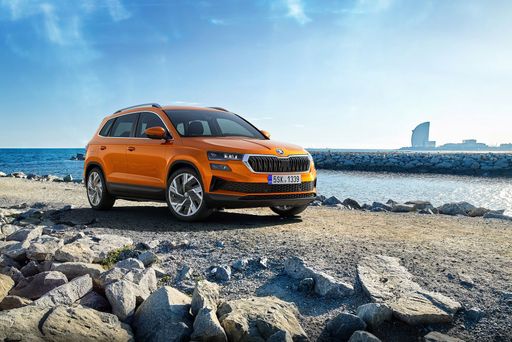 @ Škoda Auto a.s. / Škoda Storyboard
@ Škoda Auto a.s. / Škoda Storyboard
Skoda Karoq
Dacia Duster
The Dacia Duster is a no-nonsense compact SUV that delivers rugged practicality and surprisingly comfortable everyday driving without fuss. It might not win any beauty contests, but its honest design, easy-to-live-with cabin and tough attitude make it a smart pick for buyers who want reliable transport without luxury frills.
details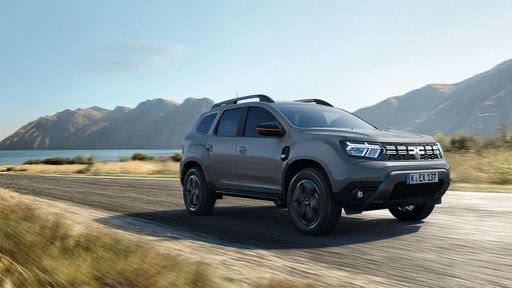 @ Dacia / Renault Group Media
@ Dacia / Renault Group Media
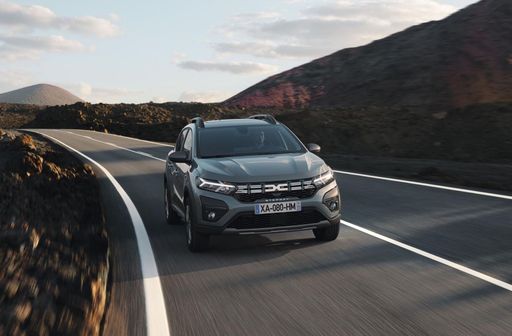 @ Dacia / Renault Group Media
@ Dacia / Renault Group Media
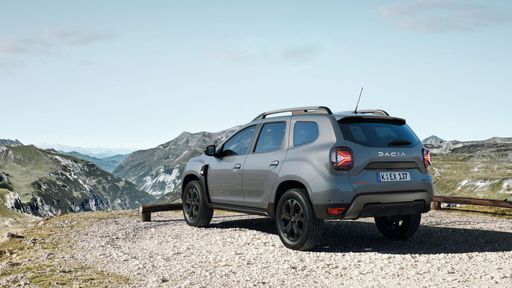 @ Dacia / Renault Group Media
@ Dacia / Renault Group Media
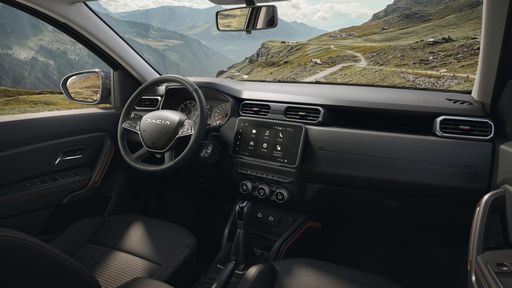 @ Dacia / Renault Group Media
@ Dacia / Renault Group Media
Skoda Karoq
The Skoda Karoq is a smart, unfussy compact SUV that blends roomy practicality with a pleasantly composed driving character. It won’t turn heads at a car meet, but it will make daily life easier with clever storage, sensible ergonomics and a reassuringly grown-up ride.
details @ Škoda Auto a.s. / Škoda Storyboard
@ Škoda Auto a.s. / Škoda Storyboard
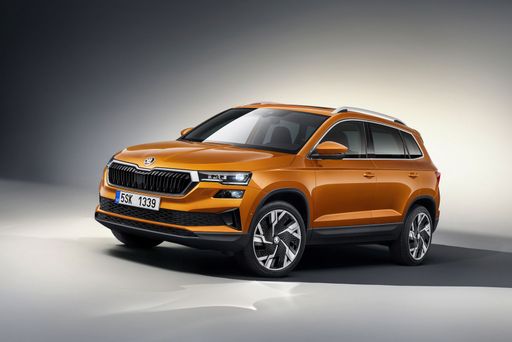 @ Škoda Auto a.s. / Škoda Storyboard
@ Škoda Auto a.s. / Škoda Storyboard
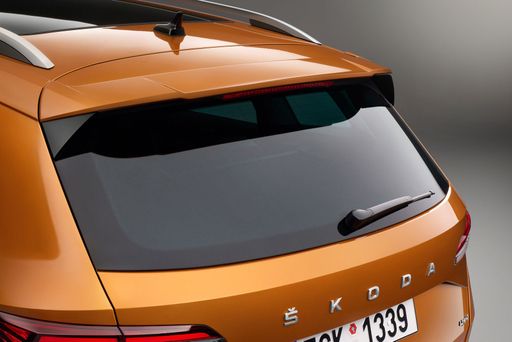 @ Škoda Auto a.s. / Škoda Storyboard
@ Škoda Auto a.s. / Škoda Storyboard
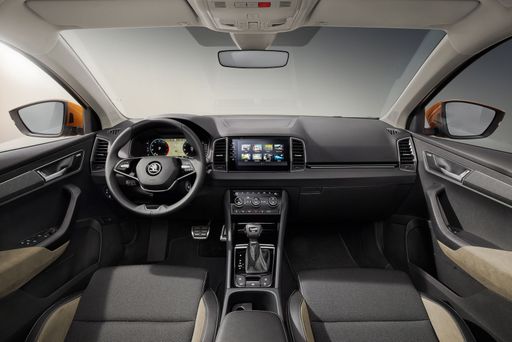 @ Škoda Auto a.s. / Škoda Storyboard
@ Škoda Auto a.s. / Škoda Storyboard
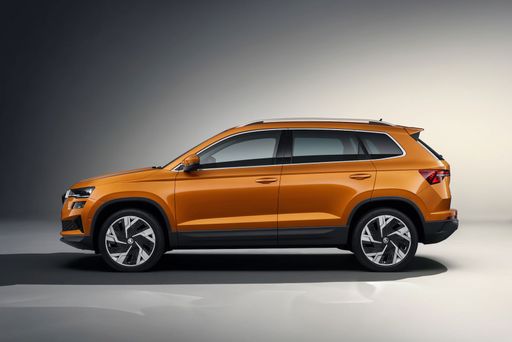 @ Škoda Auto a.s. / Škoda Storyboard
@ Škoda Auto a.s. / Škoda Storyboard
 @ Dacia / Renault Group Media
@ Dacia / Renault Group Media
|
 @ Škoda Auto a.s. / Škoda Storyboard
@ Škoda Auto a.s. / Škoda Storyboard
|
|
|
|
Costs and Consumption |
|
|---|---|
|
Price
16300 - 24900 £
|
Price
29100 - 41700 £
|
|
Consumption L/100km
4.7 - 7.5 L
|
Consumption L/100km
4.9 - 7.6 L
|
|
Consumption kWh/100km
-
|
Consumption kWh/100km
-
|
|
Electric Range
-
|
Electric Range
-
|
|
Battery Capacity
0.60 kWh
|
Battery Capacity
-
|
|
co2
107 - 124 g/km
|
co2
128 - 173 g/km
|
|
Fuel tank capacity
50 L
|
Fuel tank capacity
50 - 55 L
|
Dimensions and Body |
|
|---|---|
|
Body Type
SUV
|
Body Type
SUV
|
|
Seats
5
|
Seats
5
|
|
Doors
5
|
Doors
5
|
|
Curb weight
1377 - 1455 kg
|
Curb weight
1380 - 1655 kg
|
|
Trunk capacity
348 - 517 L
|
Trunk capacity
521 L
|
|
Length
4343 mm
|
Length
4384 - 4390 mm
|
|
Width
1813 mm
|
Width
1841 mm
|
|
Height
1656 - 1659 mm
|
Height
1624 - 1629 mm
|
|
Max trunk capacity
1414 - 1609 L
|
Max trunk capacity
1630 L
|
|
Payload
450 - 453 kg
|
Payload
456 - 549 kg
|
Engine and Performance |
|
|---|---|
|
Engine Type
Petrol MHEV, Full Hybrid, LPG
|
Engine Type
Petrol, Diesel
|
|
Transmission
Manuel, Automatic
|
Transmission
Manuel, Automatic
|
|
Transmission Detail
Manual Gearbox, Automated Manual, Dual-Clutch Automatic
|
Transmission Detail
Manual Gearbox, Dual-Clutch Automatic
|
|
Drive Type
Front-Wheel Drive, All-Wheel Drive
|
Drive Type
Front-Wheel Drive, All-Wheel Drive
|
|
Power HP
115 - 158 HP
|
Power HP
115 - 190 HP
|
|
Acceleration 0-100km/h
9.4 - 11.6 s
|
Acceleration 0-100km/h
7 - 11.2 s
|
|
Max Speed
180 km/h
|
Max Speed
192 - 221 km/h
|
|
Torque
190 - 230 Nm
|
Torque
200 - 360 Nm
|
|
Number of Cylinders
3 - 4
|
Number of Cylinders
3 - 4
|
|
Power kW
84 - 116 kW
|
Power kW
85 - 140 kW
|
|
Engine capacity
1199 - 1789 cm3
|
Engine capacity
999 - 1984 cm3
|
General |
|
|---|---|
|
Model Year
2025
|
Model Year
2025
|
|
CO2 Efficiency Class
D, C
|
CO2 Efficiency Class
D, E, F
|
|
Brand
Dacia
|
Brand
Skoda
|
What drivetrain options does the Dacia Duster have?
The Dacia Duster is offered with Front-Wheel Drive or All-Wheel Drive.
The prices and data displayed are estimates based on German list prices and may vary by country. This information is not legally binding.
